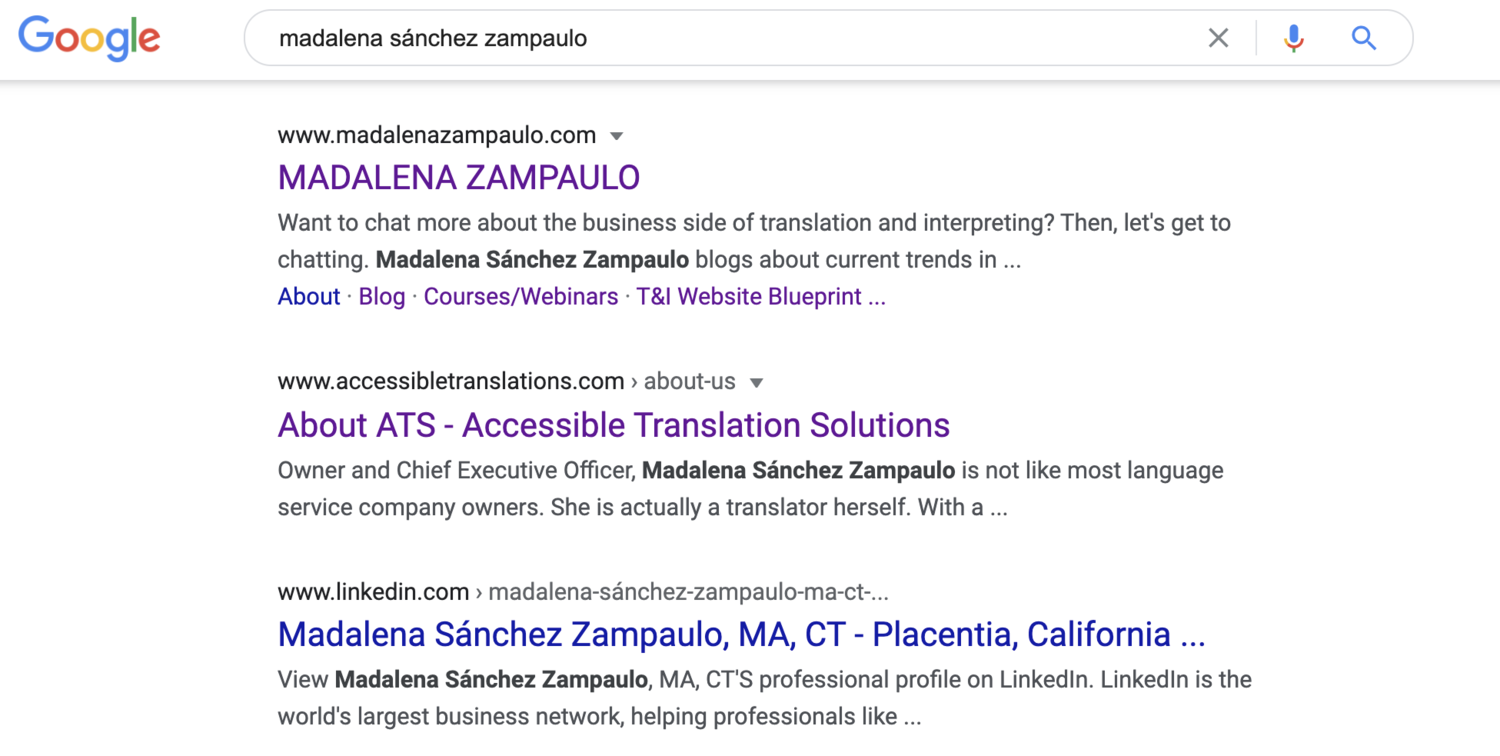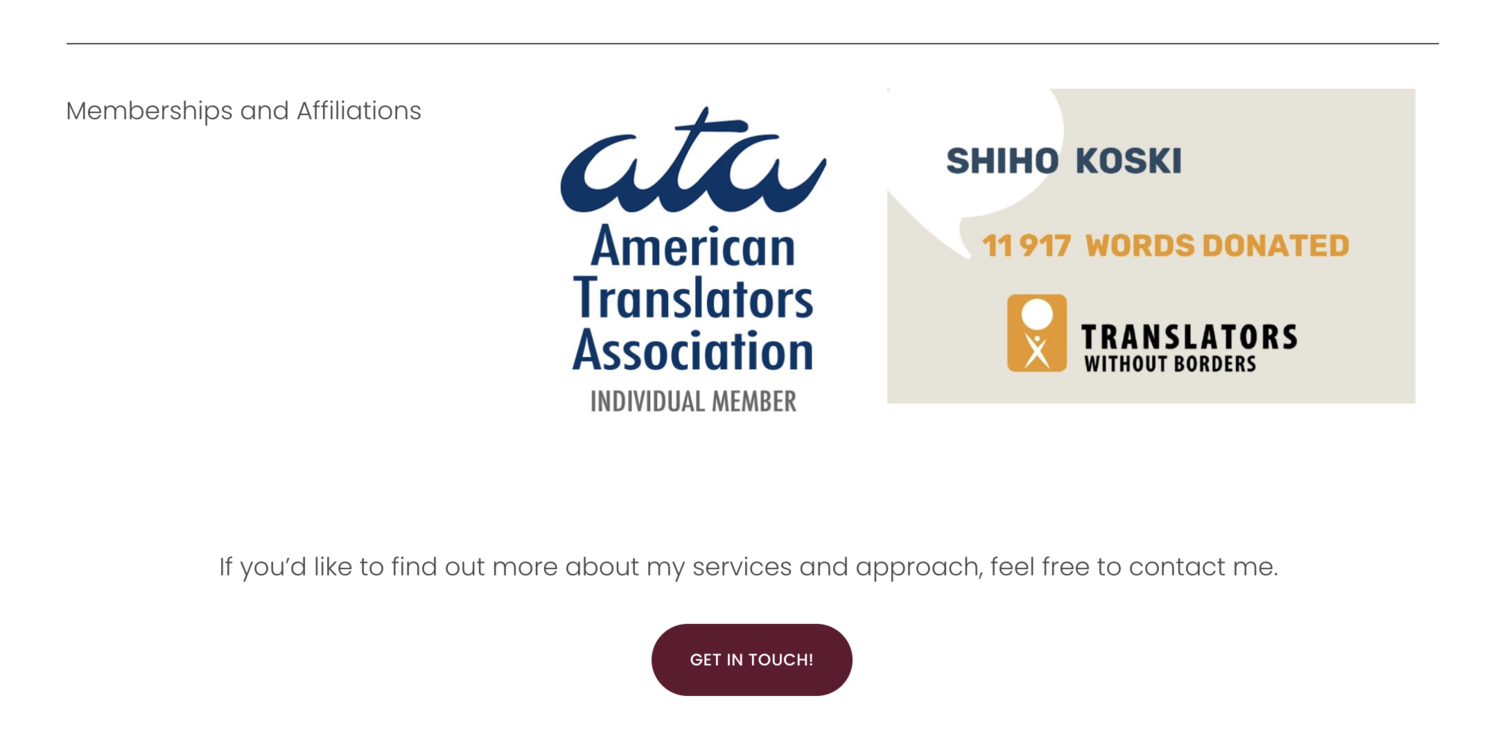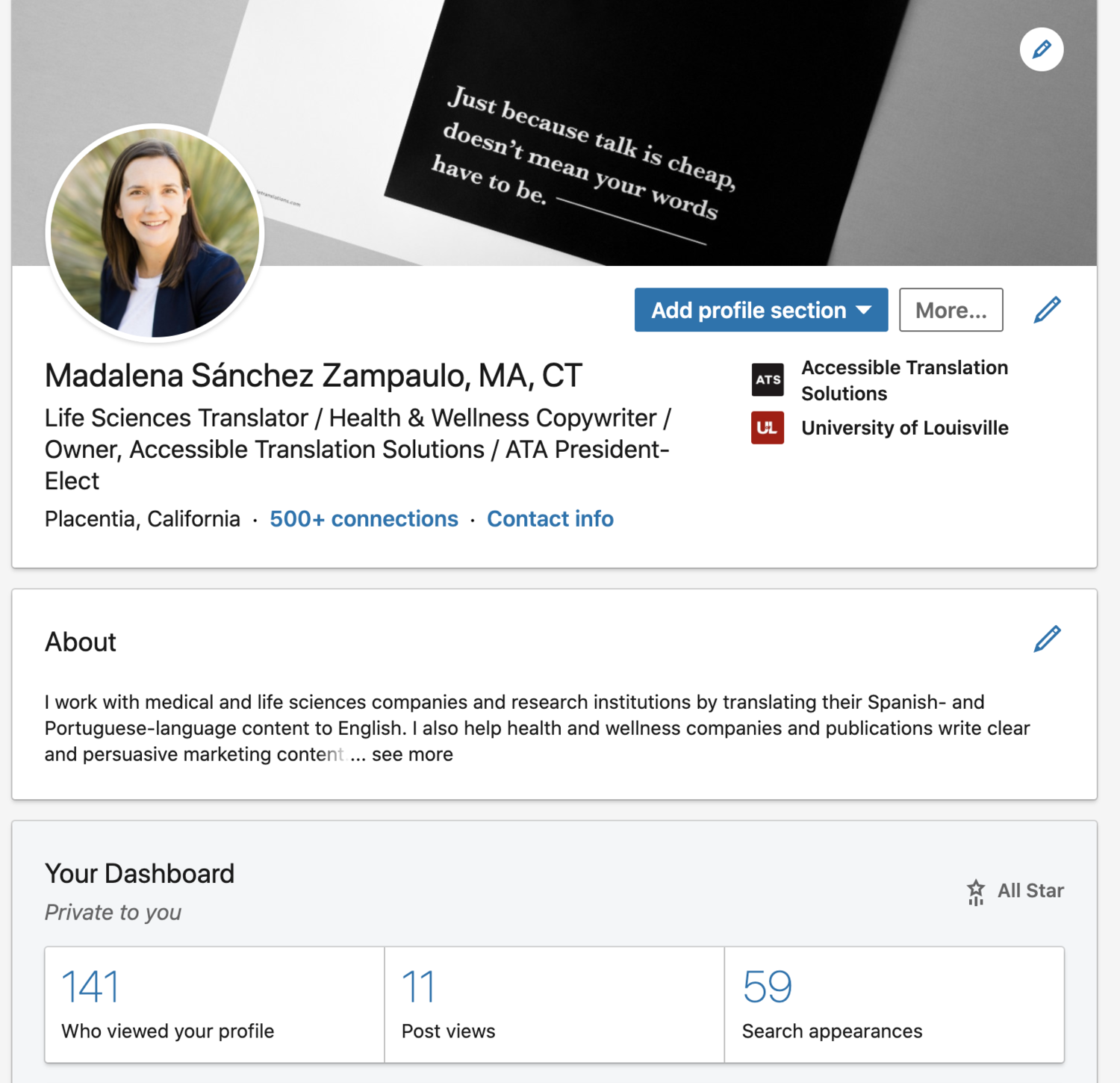How to Hone Your Online Professional Translator or Interpreter Profiles
Your online presence is about much more than your website.
Yes, your website is arguably the most important tool in your online presence arsenal. However, it's not the only place that potential clients can find you online.
In fact, if someone conducts a Google search for a translator or interpreter with some of your professional characteristics, various hits for your name might show up in their search results from different online profiles or sites.
This is just a given if you've been a practicing translator or interpreter for a while.
In fact, go ahead… Google yourself. What comes up?
Here are a few of the top-ranked pages where my name shows up.
This is why it's so important to make sure that your online profiles are up-to-date, in sync, and appealing to the right people.
First, you never know where someone is going to search for a service provider like you. So, your online presence needs to be appealing no matter the platform (website) they come across.
If I search for "French culinary translator," I might get a multitude of results, right?
WRONG.
There are only two hits for "French culinary translator." One is for a translator with a ProZ profile, and the other is a profile on a website that pairs publishers and independent book authors with translators.
Not a single website, LinkedIn profile or professional association directory profile in sight.
In fact, out of curiosity, I did the same search for a Spanish culinary translator. There were ZERO results.
Ahem… French and Spanish culinary translators reading this post, you have a wide-open door to walk through. 🤓
You can bet that clients who are seriously looking for a professional translator or interpreter to hire are searching with some fairly specific keywords.
And while we can predict some of the search terms our clients might use to find us, we can't assume we know exactly what they might put into a search engine.
That's why it's vital to keep your online profiles updated and appealing to the types of clients you want to find you online.
How to hone your online professional profiles to attract the right clients
The message you send clients online should be polished and consistent, no matter what site they click to from a list of search results.
Since your online profiles appear in various places, it's important to understand that each one serves a different slightly purpose. Making them consistent and complementary is essential to appealing to the right clients for your business.
So, which profiles you should keep updated, and how do you make sure they appeal to those who come across them?
For the purposes of this post, I'll touch on the three main profiles worth getting right: your About page of your website, your LinkedIn profile, and any professional association directories profile you may have that supports your career.
I'd even go so far as to argue that you should update them in this order.
Why?
Because the only one of these three profiles you actually own is the one on your website. It's the profile you have the most control over.
Yes, your LinkedIn profile and your professional association directory profiles are important to get right, but you don't own these like you own your website. In other words, you cannot control the parameters of your profile on these pages—only the content you can feed into them.
So, hammer out the details of your About page on your website (your online home) first, and then focus on the other roads (profiles, in this case) leading to it, second.
Let's break these three types of profiles down, shall we?
About Page
This is the page of your website that probably sees the most traffic right after your Home or landing page. This is why taking the time to hone this page is key. You want those who read it to be impressed by what they find on this page. Think about the About page of your translation or interpreting website as your main profile online. Its purpose is for your potential clients to get to know more about you and your background, as well as why you are the right fit for them.
It should be your online profile that contains the most conversational copy. Imagine you are writing to your favorite client. What would you tell them about yourself?
Your About page should give potential clients a better idea of who you are and what it's like to work with you.
Here are a couple of my favorite About pages from our colleagues. Note how different they are, and yet… they're both very well done.
You can see that Ana Sofia has given a clear and effective summary of who she is and what her clients can expect from her. She also shares information about who she helps and the professional associations she's affiliated with. This is a solid formula for an effective About page.
Shiho has given her clients a full picture of her background and expertise in addition to demonstrating why her research, analysis and writing abilities will benefit them if they hire her. I also really like how well Shiho has matched her brand colors throughout her About page and website, giving potential clients a truly polished and professional impression of her.
Related Post: How to Nail the "About" Section of Your T&I Website
LinkedIn Profile
Most of us have a LinkedIn profile that we set up several years ago. And whether or not you keep up with it (no judgment if you don't… I didn't for a while until I realized how powerful LinkedIn can be!) will be the difference in what you get out of it, or not.
Those who use LinkedIn are there to make connections with other professionals.
People are using LinkedIn todo business.
So, it makes sense to have a profile and keep it up-to-date if you are interested in growing your professional network and finding new clients and opportunities.
That said, your LinkedIn profile is different from the About page of your website because it has predetermined sections that prospects can scan without reading full paragraphs of text.
For example, the very top of your profile includes your headshot, name and headline. The headline is arguably the most important of these because it's where clients learn quickly about what you do and they associate your title or job description with your name and face.
Next, they can scan the various components of your profile, clicking to expand the About section to read more about your background, or quickly scrolling down to see your previous job experience, education, volunteer activities, etc.
It's important to fill out your LinkedIn profile as completely as possible, being sure to include information that your ideal clients would find interesting and relevant to their own goals.
It's also worth noting that your LinkedIn profile should be like an extension of your website in the sense that a prospect should be able to find you on LinkedIn and click over to your website (and vice versa) to find complementary information about you.
If a client is trying to find more information about you and either your LinkedIn profile or your website seem fairly outdated or like one doesn't complement the other, they may become skeptical and move on to another translator or interpreter whose profiles are more consistent.
Just last week I received a request to connect and a LinkedIn message from a prospective client looking for someone who provides the services I offer. We set up a Zoom call, and after a few minutes, it was clear to me that she'd already visited my website as well. I was reassured, knowing that my LinkedIn profile and website are consistent and reflect the professional picture I want to portray to my clients.
Related Post: How to Use LinkedIn As an Extension of Your Translation or Interpreting Website
Professional Association Directory Profiles
Professional associations' websites are a very good place to maintain a professional directory profile as well. They typically get a lot of promising web traffic from prospective clients who are unsure where to find the service provider they need. However, yours is also not the only profile in the directory.
So, how can you stand out while maintaining a consistent professional appearance across your various online profiles?
First, it's key to remember the purpose of these association directories. Those looking for someone in your particular language pair and specialization are looking to these associations because they know they will find a pool of people they can contact.
Of the three profiles mentioned in this post, association directory profiles tend to be the most limited in terms of what you can share. Similar to LinkedIn, there are key fields you can fill in, but there are also often some limitations with regard to how much information you can provide in the space available to you.
This is why it's important to get right to the heart of what potential clients want to know when they scan your profile. Don't worry… you can still get creative!
Think about what your prospective clients might find attractive in a profile like yours.
How do you differentiate yourself from others who provide the same services in the same language pair and specialization?
What would be a selling point to them and how can you share this information succinctly and concisely?
Why should a client choose to contact you vs. someone else when reviewing the profiles of several other professionals?
Just like with LinkedIn, it's important to connect your professional association directory profile to your website. This way, clients can learn more about you beyond the scope of what you're able to share in a brief profile on an association website. I have had many clients contact me after finding my name in a professional association directory and landing on my website as a result of having come across my profile with a direct link.
Maybe you provide voiceover services and you can upload a sample of your work. Or perhaps you can include a link to a video where you share a sample of your interpreting work. Maybe you're a translator and you've written an article on a specific topic of interest to your clients.
Be open to sharing more than just the basic information in your profile. Consider what would appeal to your ideal clients and help you stand out. Develop this over time and keep your profile updated so that relevant and appealing content is always available to anyone perusing the directory for someone like you.
Speaking of updates, refresh your online profiles on a regular basis. When you update the About page of your website, check your LinkedIn and directory profiles as well to make sure they reflect similar information.
Include any contact information that may have changed so that clients can easily get in touch with you. And always include a link from your LinkedIn and professional directory association profiles back to your website.
By having profiles that are in sync, you send a clear message to potential clients that you take your work seriously and that you keep up with your online presence as part of your business.
And since more serious prospects tend to look in more than one place to learn about potential service providers, your efforts to create consistency among your professional profiles will be well worth the short amount of time you take once or twice a year to update them and keep them in sync.












